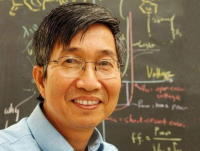










Ching W. Tang, widely considered the father of organic electronics, built the first organic solarcell and the fi rst organic light-emitting diode (OLED) in the 1980s. The enabling innovation for both devices was made possible by an organic heterojunction—a bilayer structure of an electron donor and an electron acceptor. This structure can be used to fabricate exceptionally effi cient OLEDs and organic solar cells. Tang’s insights unleashed a torrent of activity in the fi eld and eventually sparked an industry. His seminal articles on organic photovoltaics and OLEDs were published in Applied Physics Letters 48 (1986) p. 183 and 51 (1987) p. 913, respectively. Now a professor at the University of Rochester, Tang discussed with MRS Bulletin his days at Kodak.
Tang's Life and Career
Tang attended secondary school at King's College and Yuen Long Public Secondary School in Hong Kong. Later Tang graduated with a BS in chemistry from the University of British Columbia, British Columbia, Canada in 1970. He subsequently earned his PhD in physical chemistry from Cornell University, NY, USA in 1975.He joined Eastman Kodak in 1975 as a Research Scientist, was promoted to Senior Research Scientist in 1981, to Research Associate in 1990, and to Senior Research Associate in 1998. In 2003 he was named Distinguished Fellow of the Kodak Research Laboratories, Eastman Kodak Company. In 2006 he joined the University of Rochester as the Doris Johns Cherry Professor.
Tang is the inventor of several groundbreaking electronic devices, including the organic light-emitting diode (OLED),and the hetero-junction organic photovoltaic cell (OPV).Efficient OLEDs of small molecules were first developed by Tang at the research department of Eastman Kodak Company in the 1970s. Tang is widely recognized as one of the leaders in the organic electronic industry and in photovoltaics.Tang was elected to the National Academy of Engineering in 2006 for "the invention of the organic light-emitting device and organic bilayer solar cell, the bases of modern organic electronics".
In addition to his pioneer research on the OLED and OPV, Tang made a number of critical innovations resulting in the commercialization of a new flat-panel display technology. These innovations include "the development of robust transport and luminescent materials, improved device architectures, novel color pixilation methods, and fabrication processes for the manufacture of passive-matrix OLED displays; and the adaptation of active-matrix backplane technology for high-definition OLED displays".
On 15 February 2011, Tang was awarded the Wolf Prize in Chemistry. He shared the prize with Professor Stuart A. Rice of the University of Chicago, and Professor Krzysztof Matyjaszewski of Carnegie Mellon University. The official citation for the three professors from the Wolf Foundation reads: "For deep creative contributions to the chemical sciences in the field of synthesis, properties and an understanding of organic materials; for exploring the nature of organic solids and their energy profiles, structure and dynamics and for creating new ways to make organic materials, ranging from polymers, to organic-based devices that capture energy from the sun, and light our way in the dark; and for groundbreaking conceptual and experimental advances that have helped to create the research field of organic materials."
Awards
1994, Eastman Kodak Distinguished Inventor, from the Eastman Kodak Company
1999, Eastman Kodak Team Achievement Award, from the Eastman Kodak Company
2000, Eastman Innovation Award, from the Eastman Kodak Company
2001, Jan Rajchman Prize, from the Society for Information Display
2001, Carothers Award, from the American Chemical Society
2001, Northeast Regional Innovation Award, from the American Chemical Society
2002, Rochester Law Association Inventor of the Year Award, from the Rochester Intellectual Property Law Association
2003, Team Innovation Award, from the American Chemical Society
2003, Distinguished Fellow of the Kodak Research Laboratories, from the Eastman Kodak Company
2005, Humboldt Research Award, from the Alexander von Humboldt Foundation, Germany
2006, Doris Johns Cherry Professorship, from University of Rochester
2007, Daniel E. Noble Award, from the IEEE
2010, Lifetime Achievement Award, from the Hajim School of Engineering and Applied Sciences, University of Rochester
2010, Chair Professorship, from the Institute of Functional Nano & Soft Materials, Soochow University.
2011, Wolf Prize in Chemistry, from the Wolf Foundation
2013, Eduard Rhein Award, from the Eduard Rhein Foundation
2013, IAS Bank of East Asia Professorship, from the Hong Kong University of Science and Technology.
2014, Nick Holonyak Jr. Award, from the Optical Society.
Honorary Titles
2002, Honorary Professor, Shanghai University, China
2002, Honorary Professor, South China University of Technology, China
2010, Doctorate Honorary Degree, Shanghai University, China
2013, CE Hall Of Fame, from the Consumer Electronics Association.